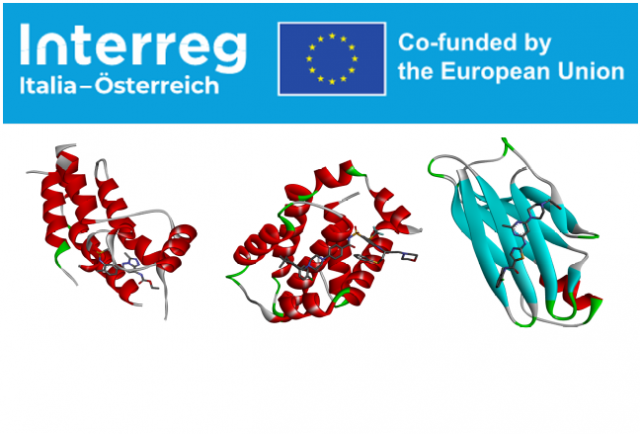The Department of Chemical and Pharmaceutical Sciences is a partner in the project SENECA

Interreg VI-A Italy Austria 2024-2027
"Epigenetics of cellular senescence in the aging process: rejuvenating the immune system to benefit human health"
Due to the increasing aging of the population, prevention and treatment of age-related diseases are of central importance in health care. Underlying aging is cellular senescence which is a state of permanent arrest of cell proliferation with loss of regenerative capacity, leading to accumulation of senescent cells in the body, progressive fibrosis of tissues and loss of their function. Particularly critical is the senescence of immune cells (immunosenescence), which results in a progressive decline of the immune response and a concomitant weakening of antitumor activity, leading to an increased risk of cancer in old age.
The goal of the SENECA project is to decipher the processes of cellular aging and search for new therapeutic agents that can also be used against cancer.
The SENECA collaborative network consists of partners with scientific paths of excellence and complementary expertise in the fields of Chemistry, Medicine, Biology and Bioinformatics, who have already successfully interacted in joint cooperation projects, such as the previous Interreg ITA-AUS EPIC project.
The University of Udine is the lead partner in the project, with Prof. Claudio Brancolini in charge.
Prof. Brancolini has an extensive experience in studying the molecular mechanisms underlying cancer and will provide expertise in understanding cellular senescence, epigenetic mechanisms related to senescence, including using genome editing and next-generation DNA sequencing (NGS) techniques.
The University of Trieste, with referee Prof. Fulvia Felluga, who specializes in organic chemistry and the synthesis of bioactive compounds, will provide expertise in the design and synthesis of new molecules capable of modulating cellular senescence also from a therapeutic perspective.
The Paris-Lodron Universität Salzburg with contact person Prof. Fritz Aberger, an expert in oncogenic signaling, tumor-immune system interactions and also immunosenescence, will develop in vitro and in vivo models to understand the role of the immune system and its aging in anti-tumor actions.
Eurac Research in Bolzano, with contact person Dr. Christian X. Weichenberger, will provide expertise in computational and statistical analysis of large datasets orginated with NGS experiments. Eurac bioinformaticians will engage in the analysis of sequencing data from various sources using a variety of state-of-the-art computational methods.
Design and synthesis of compounds with potential senolytic activity.
Senolytics are a class of compounds responsible for the selective elimination of senescent cells (SCs). The first senolytic drugs discovered were Dasatinib, Quercetin, and Navitoclax, which target SCs by inducing apoptosis. Over the years, this group of drugs has expanded to include molecules active as degraders of proteins containing the bromodomain and extra-terminal motif (BET proteins), glutaminase inhibitors, and natural compounds, including rapamycin and related macrolide compounds. Finally, a small molecule such as metformin, in addition to its typical activity in diabetes therapy, has also been shown to have senolytic activity.
Under the SENECA project, the Organic Chemistry group aims to synthesize a small library of compounds by conjugating pairs of these known senolytic molecules, following an established strategy in medicinal chemistry. The purpose of preparing such conjugates is to assess the appearance of any synergistic actions that might result in an amplification of senolytic activity, and thus to provide a new data set on this activity.
Both labile and stable bifunctional linkers consisting of short alkyl chains will be used for conjugation in the first phase of the project. A further possible development will be the synthesis of a second generation of conjugates, containing the best elements of the first group with improved ADME properties, through optimization of the linker present in the conjugates. For example, the alkyl chains will be replaced by oligo- or polyoxyethylene chains to improve the solubility and distribution of the compounds.
In the first phase of the project, PhD student Dr. Alessandro Raffa synthesized a series of bioconjugates between (+)-JQ1 and Dasatinib and between (+)-JQ1 and Metformin, linking the two units both directly and through different linkers, according to the following general scheme, with the aim of developing new molecules with increased senolytic activity.
These partners were chosen because (+)-JQ1 is known to be recognized by BET proteins, which are overexpressed in senescent cells, while Dasatinib and Metformin have previously shown senolytic activity both in vitro and in vivo.
The conjugates (7 in total) were synthesized using standard ester and amide coupling methods (HOBt/EDC), obtaining the respective products with yields in the range 65% to 95%.
The results of this work were presented in a poster communication by Dr. Alessandro Raffa at the 2025 Conference of the Division of Biological Systems Chemistry of the Italian Chemical Society, held at the University of Trieste from June 18 to 20, 2025.
Dr. Raffa also presented these results during the 2nd SENECA Meeting, which took place on July 10-11, 2025, at the Department of Chemical and Pharmaceutical Sciences of the University of Trieste, and which was attended by the research groups of all the partners involved in the project.


